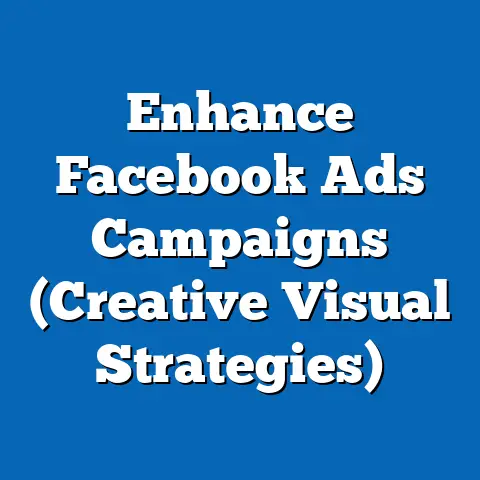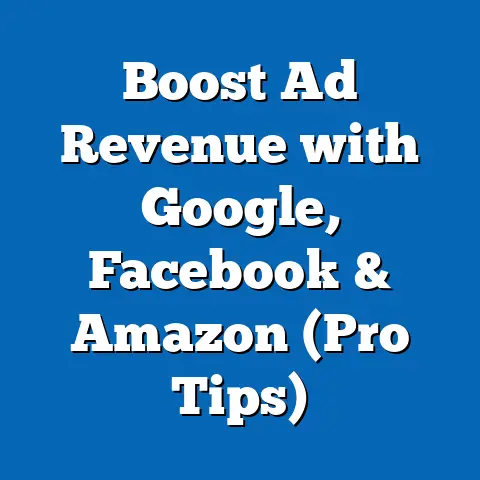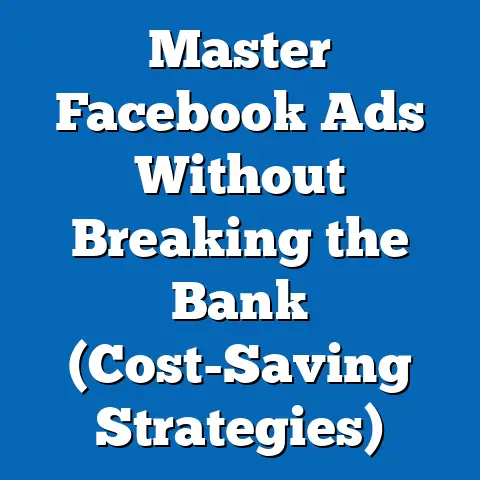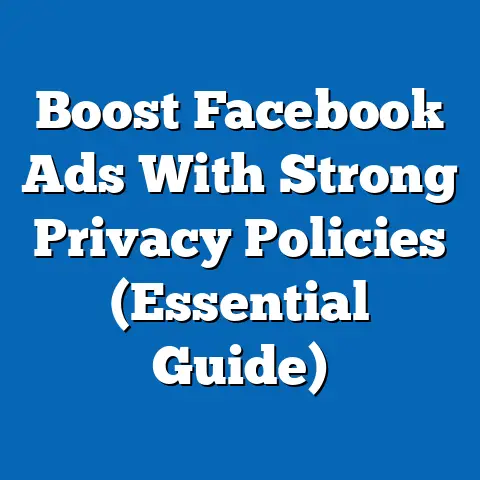Maximize Reach with Top Facebook Ad Placements (Expert Guide)
Understanding Facebook Ad Placements
Facebook advertising is a powerful tool, no doubt. But simply creating an ad and hoping for the best is like casting a wide net in the ocean without knowing where the fish are. Understanding and strategically selecting your ad placements is crucial to ensure your message reaches the right audience, on the right device, and at the right time.
So, what exactly are ad placements? In essence, they are the locations on Facebook, Instagram, Audience Network, and Messenger where your ads can appear. Facebook offers a variety of placements, each with its own unique characteristics and audience engagement patterns. Let’s break them down:
- Facebook Feed: This is the classic placement, appearing directly in users’ news feeds alongside posts from friends, family, and pages they follow. It’s highly visible and ideal for broad awareness campaigns.
- Instagram Feed: Similar to Facebook Feed, but on Instagram. This placement is visually driven and caters to a younger, more visually oriented audience. I’ve found that high-quality images and videos perform exceptionally well here.
- Facebook Stories: Short-form, full-screen content that disappears after 24 hours. Stories are great for grabbing attention quickly and driving immediate action. Vertical video is king here.
- Instagram Stories: Again, similar to Facebook Stories, but on Instagram. This placement is incredibly popular, especially with younger demographics. Interactive elements like polls and quizzes can boost engagement.
- In-Stream Video Ads: These ads play before, during, or after video content on Facebook and Instagram. They’re ideal for capturing attention with engaging video content. I’ve had success with shorter, punchier video ads in this placement.
- Audience Network: This allows your ads to appear on a network of third-party apps and websites. It’s a great way to extend your reach beyond Facebook and Instagram. However, quality control is crucial here; monitor your performance closely to ensure your ads are appearing in relevant contexts.
- Right Column Ads: These ads appear on the right side of the Facebook desktop interface. While they’re less prominent than feed ads, they can still be effective for retargeting and driving conversions.
- Facebook Marketplace: This placement is perfect for reaching users who are actively looking to buy or sell products. Target your ads based on the items people are browsing or selling.
- Messenger Ads: These can appear in the Messenger inbox or within conversations. They’re great for driving direct engagement and customer service interactions.
Each placement offers a different context and user experience. Understanding these nuances is key to crafting ads that resonate with your target audience. Don’t just blindly choose “automatic placements”; take the time to understand where your audience spends their time and tailor your ads accordingly.
Takeaway: Familiarize yourself with the different Facebook ad placements and their unique characteristics.
The Importance of Placement Selection
Choosing the right ad placements isn’t just a minor detail; it’s a fundamental element of a successful Facebook advertising campaign. Think of it as selecting the right fishing rod, bait, and location for the type of fish you’re trying to catch. A mismatch can lead to wasted resources and disappointing results.
The impact of placement selection is multi-faceted:
- Reaching the Right Audience: Different placements attract different demographics and psychographics. For example, Instagram is heavily favored by younger audiences, while Facebook has a broader demographic reach. Audience Network can tap into niche interests and behaviors across a wide range of apps and websites. By understanding where your target audience spends their time, you can significantly improve your ad relevance and engagement.
- Optimizing Ad Format: Each placement has its own ideal ad format. Vertical videos thrive in Stories, while high-quality images perform well in Feeds. Trying to force a square image into a Stories placement, for example, will result in a poor user experience and reduced performance.
- Maximizing Ad Spend: By focusing your budget on the placements that deliver the best results, you can significantly improve your return on investment (ROI). I’ve seen campaigns where simply shifting budget from underperforming placements to top performers resulted in a 2x or even 3x increase in conversions.
- Improving Ad Relevance: When your ad appears in a context that is relevant to the user’s interests and behaviors, they’re more likely to engage with it. For example, showing a product ad in the Facebook Marketplace to someone who has been browsing similar items is far more effective than showing it in their general news feed.
- Enhancing User Experience: Nobody likes intrusive or irrelevant ads. By choosing placements that blend seamlessly with the user experience, you can reduce ad fatigue and improve brand perception.
Statistics and Data:
- According to Facebook, businesses see an average of 7.4x return on ad spend when using Facebook ads. However, this ROI is heavily dependent on effective placement selection and targeting.
- A study by Statista found that mobile advertising spend is projected to reach \$339 billion in 2023, highlighting the importance of optimizing for mobile placements like Feeds and Stories.
- Internal Facebook data shows that ads optimized for specific placements (e.g., vertical video for Stories) typically outperform generic ads by 20-30%.
Case Study:
I once worked with an e-commerce client selling fitness apparel. Initially, they were running a single ad campaign across all placements with a generic square image. The results were mediocre, with a low click-through rate (CTR) and high cost per acquisition (CPA).
We decided to overhaul their strategy. We created separate campaigns for Facebook Feed, Instagram Feed, and Instagram Stories, each with optimized ad formats. We used high-quality lifestyle images for the Feeds and engaging vertical videos for Stories. We also leveraged retargeting to show ads to users who had previously visited their website.
The results were dramatic. The CTR increased by 150%, the CPA decreased by 60%, and overall sales tripled. The key was understanding the nuances of each placement and tailoring the ads accordingly.
Takeaway: Placement selection is critical for reaching the right audience, optimizing ad format, maximizing ad spend, improving ad relevance, and enhancing user experience.
Best Practices for Choosing Ad Placements
Now that we understand the importance of placement selection, let’s dive into the best practices for choosing the right placements for your campaigns. This isn’t a one-size-fits-all approach; the optimal placements will depend on your specific goals, target audience, and ad creative.
Here’s a step-by-step guide:
- Define Your Campaign Goals: What are you trying to achieve with your Facebook ads? Are you looking to increase brand awareness, drive website traffic, generate leads, or boost sales? Your goals will heavily influence your placement choices. For example, if you’re focused on brand awareness, you might prioritize placements with high reach, like Facebook Feed and Audience Network. If you’re focused on conversions, you might prioritize placements with high engagement, like Instagram Feed and Stories.
- Understand Your Target Audience: Who are you trying to reach with your ads? What are their demographics, interests, and behaviors? Where do they spend their time online? Use Facebook Audience Insights to gather data on your target audience and identify the placements they’re most likely to engage with.
- Analyze Your Ad Creative: What type of ad creative are you using? Are you using images, videos, or a combination of both? Each placement has its own ideal ad format. Ensure your ad creative is optimized for the placements you’re targeting. For example, use vertical videos for Stories and high-quality images for Feeds.
- Start with Automatic Placements (but Don’t Stay There): Facebook’s “automatic placements” option allows the algorithm to automatically distribute your ads across all available placements. This can be a good starting point for gathering data and identifying top-performing placements. However, I strongly recommend transitioning to manual placements once you have enough data to make informed decisions.
- A/B Test Your Placements: A/B testing is crucial for determining the most effective placements for your campaigns. Create separate ad sets for different placements and track their performance. Compare metrics like impressions, clicks, CTR, CPA, and conversion rate to identify the top performers.
- Monitor and Optimize: Continuously monitor the performance of your ad placements and make adjustments as needed. As your campaigns evolve and your audience changes, your optimal placements may also change. Use Facebook Ads Manager to track your performance and identify areas for improvement.
- Consider Mobile vs. Desktop: Mobile devices account for a significant portion of Facebook’s ad revenue. Ensure your ads are optimized for mobile placements like Feeds and Stories. However, don’t completely ignore desktop placements. Right column ads can still be effective for retargeting and driving conversions.
- Leverage Facebook Pixel Data: The Facebook Pixel tracks user behavior on your website, providing valuable insights into which placements are driving the most valuable traffic. Use this data to optimize your placement strategy and target users who are most likely to convert.
Tools and Analytics:
- Facebook Ads Manager: This is your primary tool for creating, managing, and analyzing your Facebook ad campaigns. Use it to track the performance of your ad placements and identify areas for improvement.
- Facebook Analytics: This tool provides insights into user behavior across your website, app, and Facebook page. Use it to understand how users are interacting with your content and identify the placements that are driving the most valuable traffic.
- Google Analytics: This tool provides detailed insights into website traffic and user behavior. Use it to track conversions and attribute them to specific Facebook ad placements.
Takeaway: Define your goals, understand your audience, analyze your ad creative, A/B test your placements, and continuously monitor and optimize your campaigns.
Advanced Strategies for Optimizing Ad Placements
Once you’ve mastered the basics of placement selection, it’s time to explore some advanced strategies for further optimizing your campaigns and maximizing your reach. These strategies involve a deeper understanding of Facebook’s advertising platform and a willingness to experiment and iterate.
- Retargeting with Placement Specificity: Retargeting allows you to show ads to users who have previously interacted with your website or app. By combining retargeting with placement specificity, you can create highly relevant and personalized ad experiences. For example, you could show a product ad in the Facebook Marketplace to users who have previously viewed that product on your website. Or, you could show a lead generation ad in the Instagram Feed to users who have previously downloaded a whitepaper from your website.
- Dynamic Ads for Multiple Placements: Dynamic ads automatically show the most relevant products to users based on their browsing history and interests. By leveraging dynamic ads across multiple placements, you can create a seamless and personalized shopping experience. For example, you could show dynamic product ads in the Facebook Feed, Instagram Feed, and Audience Network, all tailored to the user’s individual preferences.
- Custom Audiences and Lookalike Audiences: Custom audiences allow you to target users based on your own data, such as email lists or website visitors. Lookalike audiences allow you to reach new users who are similar to your existing customers. By combining custom audiences and lookalike audiences with placement specificity, you can significantly expand your reach and target highly qualified leads. For example, you could create a lookalike audience based on your top customers and target them with ads in the Instagram Stories placement.
- Placement Asset Customization: Facebook allows you to customize your ad creative for different placements. This means you can tailor your headlines, descriptions, and call-to-action buttons to resonate with users in each specific environment. For example, you might use a shorter, punchier headline in the Instagram Feed and a longer, more descriptive headline in the Facebook Feed.
- Leveraging Video Placements for Storytelling: Video is a powerful medium for storytelling, and Facebook’s video placements offer a great opportunity to connect with your audience on an emotional level. Consider creating short, engaging video ads for placements like Facebook Stories and In-Stream Video Ads. Use compelling visuals, relatable characters, and a clear call-to-action to drive results.
- Experimenting with New Placements: Facebook is constantly introducing new ad placements. Be willing to experiment with these new placements and see if they can help you reach new audiences or improve your campaign performance. For example, Facebook recently introduced Reels ads, which allow you to show ads within the Reels feed on Facebook and Instagram.
Takeaway: Leverage retargeting, dynamic ads, custom audiences, placement asset customization, video storytelling, and experimentation to optimize your ad placements and maximize your reach.
Analyzing and Measuring Success
The final, and arguably most important, step in optimizing your Facebook ad placements is to analyze your results and measure your success. Without data, you’re just guessing. You need to track the right metrics, understand what they mean, and use that information to make informed decisions about your campaigns.
Here are the key performance indicators (KPIs) you should be tracking:
- Impressions: The number of times your ad was shown. This is a basic measure of reach and awareness.
- Reach: The number of unique users who saw your ad. This is a more accurate measure of reach than impressions, as it accounts for users who saw your ad multiple times.
- Clicks: The number of times users clicked on your ad. This is a measure of engagement and interest.
- Click-Through Rate (CTR): The percentage of users who saw your ad and clicked on it (Clicks / Impressions). This is a measure of ad relevance and effectiveness.
- Cost Per Click (CPC): The average cost you paid for each click on your ad. This is a measure of ad efficiency.
- Conversions: The number of users who completed a desired action after clicking on your ad (e.g., made a purchase, filled out a form, downloaded a whitepaper). This is a measure of campaign success.
- Conversion Rate: The percentage of users who clicked on your ad and completed a desired action (Conversions / Clicks). This is a measure of website or landing page effectiveness.
- Cost Per Acquisition (CPA): The average cost you paid for each conversion. This is a measure of overall campaign efficiency.
- Return on Ad Spend (ROAS): The revenue you generated from your ads divided by the amount you spent on those ads. This is a measure of campaign profitability.
Using Facebook Ads Manager for Analysis:
Facebook Ads Manager provides a wealth of data on your ad performance. Use it to track your KPIs, compare the performance of different placements, and identify areas for improvement.
Here’s how to use Facebook Ads Manager for placement analysis:
- Go to Facebook Ads Manager.
- Select the campaign, ad set, or ad you want to analyze.
- Click on the “Columns” dropdown and select “Customize Columns.”
- Choose the metrics you want to track (e.g., Impressions, Reach, Clicks, CTR, CPC, Conversions, CPA, ROAS).
- Click on “Breakdown” and select “Placement.”
This will show you the performance of your ads across different placements. You can then sort the data by any of the metrics to identify the top-performing and underperforming placements.
Ongoing Analysis and Iteration:
Analyzing your data is not a one-time task. You need to continuously monitor your performance and make adjustments as needed. As your campaigns evolve and your audience changes, your optimal placements may also change.
Here are some tips for ongoing analysis and iteration:
- Set up regular reporting: Schedule regular reports to track your KPIs and identify trends.
- A/B test continuously: Continuously test different placements, ad creative, and targeting options to optimize your campaigns.
- Stay up-to-date: Facebook is constantly evolving its advertising platform. Stay up-to-date on the latest features and best practices to ensure you’re maximizing your results.
Takeaway: Track your KPIs, use Facebook Ads Manager for analysis, and continuously monitor and optimize your campaigns.
Conclusion
Maximizing reach with Facebook ad placements is a complex but crucial aspect of successful Facebook advertising. By understanding the different placements available, the importance of placement selection, and the best practices for choosing and optimizing your placements, you can significantly improve your campaign performance and achieve your business goals.
Remember, it’s not just about throwing money at Facebook; it’s about being smart, strategic, and data-driven. Define your goals, understand your audience, analyze your ad creative, A/B test your placements, and continuously monitor and optimize your campaigns.
By investing the time and effort to master Facebook ad placements, you can unlock the full potential of Facebook advertising and drive significant growth for your business.
So, what are you waiting for? Dive into Facebook Ads Manager, experiment with different placements, and start maximizing your reach today! I’m confident that with the knowledge and strategies outlined in this guide, you’ll be well on your way to achieving Facebook advertising success.






